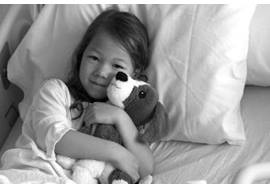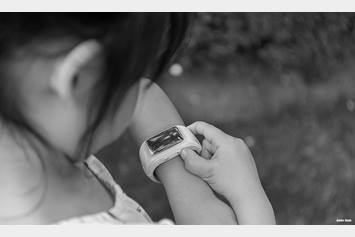Epilepsy Surgery
Considerations for Medically Intractable Epilepsy
Inside Our Level 4 Epilepsy Center
Watch Here
Epilepsy Surgery
Childhood-onset epilepsy affects 1 percent of children worldwide. About 25 to 30 percent of these will have medically intractable epilepsy, continuing to have seizures despite using two or more antiseizure medications.
Options for this group of patients included intracranial epilepsy surgery, vagus nerve stimulator (VNS) insertion, ketogenic diet and drug trials. It is increasingly recognized that epilepsy surgery may dramatically improve the quality of life for these children and is the only potentially curative option.
At Nationwide Children’s, we are leaders in the growing field of epilepsy surgery. Through our patient-centered focus, our epileptologists work with families to explain available options, how the processes for the options work and the associated risks and benefits of epilepsy surgery. The epilepsy care team is devoted to providing the best option for seizure management for each patient and works closely with the primary care provider to coordinate care for patients.

Nationwide Children's Hospital is ranked by U.S. News & World Report for Neurology and Neurosurgery.
Our Team
Our interdisciplinary team includes:
- Pediatric neurologists/epileptologists
- Pediatric neurosurgeons
- Pediatric ophthalmologists
- Pediatric nurse practitioners
- Clinical pharmacists
- Pediatric neuropsychologists, psychologists and behavioral specialists
- Clinical social workers
- Epilepsy Foundation educators
- Child Life specialists
- Dietitians
- Genetic counselors
- Pathologists
- Neurodiagnostic technicians
- Nuclear medicine specialists
- Neuroradiologists
- Administrative support
Meet the Epilepsy Surgery Team
For Medical Professionals – Why Choose Us?
Epilepsy Surgery at Nationwide Children’s is a Germain Family Accelerator Program, a designation that provides additional funding to speed the integration of clinical care and research to make the largest impact on child health outcomes. From groundbreaking research to cutting-edge advances in neurosurgery, Nationwide Children’s is committed to making a difference and improving the health of children everywhere.
Leadership

Adam P. Ostendorf
Adam Ostendorf, MD, is an attending pediatric neurologist at Nationwide Children's Hospital and assistant professor of Clinical Pediatrics and Neurology at The Ohio State University College of Medicine.

Ammar Shaikhouni
Ammar Shaikhouni, MD, PhD, is a pediatric neurosurgeon at Nationwide Children’s Hospital and assistant professor of neurological surgery at The Ohio State University College of Medicine.
What are the Surgical Options?
Palliative surgical options include Corpus callosotomy or VNS insertion.
Single stage surgery is performed if imaging and phase 1 data demonstrate concordant findings suggesting lesional epilepsy. It involves resection of the lesion and electrocorticography to ensure all abnormal tissue is removed. Alternatively, diffuse pathology affecting a cerebral hemisphere may warrant hemispherectomy/hemispherotomy.
Two stage surgery is performed when phase 1 monitoring contains discordant data or inadequately localizes the epileptigenic zone. After phase 1 monitoring, the patient undergoes stage 1 surgery, during which a subdural convexity grid is placed over the cortical surface. The electrodes are secured in place as the dura is closed. Then, in phase two monitoring, continuous long term intracranial EEG is monitored for approximately one week to identify abnormal electrical signals before and during seizures. This approach allows identification of the epileptigenic zone, potential adjacent areas of abnormal electrical activity and nearby eloquent functional areas of the brain. Eloquent areas of cortex are localized by cortical stimulation mapping. Additional discussion at the epilepsy surgery conference near the end of phase 2 monitoring solidifies the surgical plan. Stage 2 surgery typically involves a grid-based resection of the epileptigenic zone with careful preservation of the eloquent functional areas. Following surgery, patients are monitored closely in the pediatric intensive care unit before transfer to the neurosurgery floor for further recovery.
Deciding if Surgery is the Right Choice
For patients whose epilepsy is not well controlled with medication, the neurologist may suggest phase 1 monitoring. This phase is an extensive presurgical workup that helps the neurologist localize the seizures and determine the patient’s candidacy for epilepsy surgery. It involves multiple-day inpatient admission, prolonged video electroencephalogram (EEG) and intended observation of at least three typical seizures.
Diagnostic studies for surgery evaluation include some or all of the following:
- 24-hour, long-term video EEG monitoring in a unit specifically designed for children
- Diffusion tensor imaging
- Functional magnetic resonance imaging (MRI)
- High field, detailed MRI
- Neuropsychological evaluation
- Positron emission testing (PET)
- Routine digital/video EEG
- Intra-operative and extra-operative studies to localize language and motor functions
- Single photon emission computerized tomography
While seizures for many patients can be controlled effectively with medication, about 25 to 30 percent of children continue to have difficult-to-control epilepsy. Some of these patients may benefit from surgical intervention. Curative surgery for seizures includes operating on the portion of the brain responsible for seizure onset. Other special surgical procedures, such as a hemispherectomy, corpus callosotomy or implantation of vagus nerve stimulators, are used to improve seizure control.
As a level-four Epilepsy Center, we are able to assess children with medically refractory seizures where the cause of the seizure is identified by MRI abnormality, as well as cases where the MRI is normal. We also conduct functional cortical mapping by stimulation of subdural electrodes either extra-operatively or intraoperatively.
Behind the Scenes on the Epilepsy Unit
Inside Epilepsy Surgery

Meet Gaige
When the seizures started at 3 years old, Gaige had a couple per week. As he grew, they became more frequent and difficult to manage. At one point, Gaige was having nine to 10 seizures a week, sometimes more than one in the same night.











